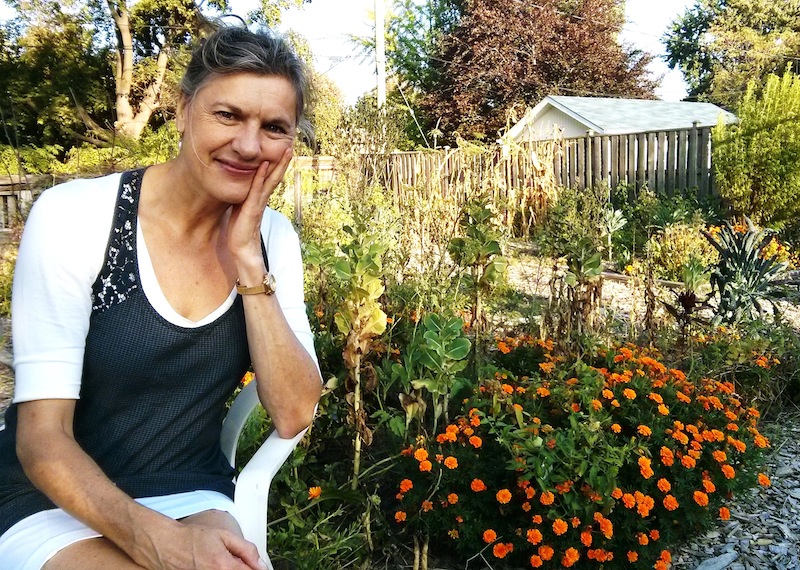Some of Windsor’s most vulnerable citizens are benefiting from a community garden that’s been churning out fresh, local organic produce for the last several years.
But the mission of the University of Windsor’s Campus Community Garden Project goes far beyond one branch of altruism.
“Feeding the community is very important, but even more important is empowering people and teaching them how to grow their own food,” said Rita Haase, the project’s founder and a sessional instructor in the university’s Women’s Studies department and Faculty of Education. “That’s what we do here.”
Launched in 2010, the garden sits on less than an acre of urban property on California Avenue, on the eastern edge of campus, where three vacant homes used to stand.
It’s extremely small by modern-day super-farm standards, but it’s also very efficient. Last year alone, it produced an estimated 600 pounds of produce, the majority of which went to community support initiatives like the local women’s shelter and the Downtown Mission, which provides food and shelter for Windsor’s homeless.
The project’s volunteers grow a variety of fruits and vegetables, including tomatoes, cucumbers, lettuce, zucchini, eggplant, potatoes, beets, herbs and several different types of berries, all of which are harvested twice a week during prime growing season. Some of the food is donated to the Green Bean Café, a popular university eatery located in the basement of a nearby church. Volunteers even set up a table at times when they can hand out free produce directly to students.
“They love it,” Dr. Haase said of the garden’s recipients. “It’s fresh, local, nutritious produce. This is definitely a good size for a garden where you can really produce something valuable. It’s a very good concept.”
That concept is a multi-faceted one. Besides providing fresh produce for vulnerable populations, it engages the campus community, educates people about organic agriculture and improves campus biodiversity.
“It offers habitat for a variety of species,” said Haase, who has a master’s degree in education and a PhD in biology. “It makes the soil healthier and improves the air quality.”
The garden has two main growing areas — the “keyhole garden” and the “independence garden” — where volunteers have adopted a perma-culture approach. No one is allowed to use any chemicals or fertilizers. They use mulch, compost or donated manure and don’t till the soil. They have three 1,000-litre rain barrels to water all the plants.
“We use as little resources as possible, and we try to teach that,” she said. “The educational component is obvious, given that we are a university campus.”
They also practice “companion planting,” which involves planting different varieties close to one another, which Haase said is a natural way to fend off insects, while releasing natural chemical compounds and bacteria into the soil that improves its quality and increases production.
“You work with nature, not against it,” she explained. “You minimize the workload to the benefit of the plants. I believe the quality of the produce is better. It’s a little smaller, but that’s because it’s not artificially pumped up.”
There are also a number of individual allotments for neighbouring gardeners who can grow whatever they choose on their own small plots, as long as they give 10 per cent of their yield to the garden’s community initiatives.
The project’s success relies heavily on contributions from faculty, staff and area neighbours, and they have a list of about 200 volunteers who regularly pitch in.
“Anyone can come,” said Haase. “They arrive, we explain what needs to be done and they do what they like doing. This really is a passion and this unites people. And it’s a lot of fun.”
The project is also a part of the Windsor-Essex County Community Garden Collective, which brings all area community garden initiatives together and organizes distribution of the produce they grow.
The project’s concept was originally pitched by Haase in the 2009-10 academic year to the university’s environmental committee, a group of faculty, staff members and students pulled together to discuss ways of making the university more sustainable while reducing its carbon footprint.
The idea was born out of what she believed was a lack of sustainable environmental initiatives on campus at the time.
“We have a lot of park-like areas, which are well-kept and nice to look at, but they’re not productive in terms of environmental sustainability or food production,” she said.
Haase, who was born and raised in Germany and has been gardening most of her life, wanted to find a way to help bridge the campus community with the surrounding neighbours.
“Some people in the neighbourhood have had bad experiences with the campus community, whether because of noise from students partying, traffic, or parking,” she said.
The committee loved the idea, the university offered up the land for use and by February of 2010, volunteers were already starting to prepare for that spring’s planting. The university’s grounds crew cleaned up and roto-tilled the property.
“It looked like a wasteland,” she recalls. “There was lots of rubble and litter. It was an eyesore.”
Three years later, the project is still going strong, fulfilling its original mandate and will continue as long as the university allows it to use the land.
“We’ve created a place where people like to be, where they work together and can be closer to nature,” Haase said. “It’s created a community that helps individuals stay healthier, and hopefully, happier. This is a little piece of paradise, a stretch of nature that we often miss in cities. This is the most sustainable thing you can do, in my opinion.”
Alan Scofield is a local freelancer who writes about science, business, lifestyles and entertainment who tries to eat local whenever possible.




